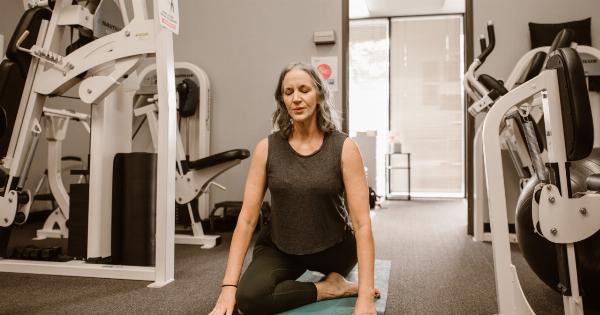Many women experience period pain, also known as dysmenorrhea, during their menstrual cycle. This can be a debilitating condition that affects daily activities and quality of life.
While medication is commonly used to manage period pain, exercise is an effective non-medicinal solution that can provide relief and improve overall well-being. In this article, we will explore the benefits of exercise for period pain and discuss the various types of exercises that can help alleviate this discomfort.
The Benefits of Exercise for Period Pain
Exercise has been found to have numerous benefits for managing period pain. Here are some of the key advantages:.
1. Increased Endorphin Release
When we exercise, our body releases endorphins, which are natural painkillers and mood boosters. These endorphins can help reduce the intensity of period pain and provide a sense of well-being.
2. Improved Blood Circulation
Exercise promotes better blood circulation throughout the body, including the pelvic region. This increased blood flow helps to reduce muscle tension and relieve cramps associated with period pain.
3. Reduction in Prostaglandin Levels
Prostaglandins are hormone-like substances that are responsible for triggering uterine contractions during menstruation. High levels of prostaglandins can lead to more severe period pain.
Exercise has been shown to reduce the production of prostaglandins, thereby decreasing the intensity of cramps.
4. Enhanced Mood and Stress Relief
Regular exercise has a positive impact on mental health, leading to improved mood and reduced stress levels. This is particularly beneficial for those experiencing period pain, as stress can exacerbate the intensity of pain.
Types of Exercises for Period Pain
There are various types of exercises that can help alleviate period pain. It’s important to choose exercises that you enjoy and feel comfortable doing. Here are some examples:.
1. Aerobic Exercises
Aerobic exercises such as jogging, cycling, or dancing increase heart rate and promote the release of endorphins. These activities also improve blood circulation, which can reduce muscle tension and alleviate cramps associated with period pain.
2. Yoga
Yoga combines physical movement with deep breathing and relaxation techniques, making it an excellent choice for managing period pain.
Certain yoga poses, such as child’s pose, cat-cow, and pigeon pose, can specifically target pelvic pain and provide relief.
3. Pilates
Pilates focuses on core strength and flexibility. The exercises in Pilates help improve posture and strengthen the muscles supporting the pelvis, reducing period pain and cramping.
4. Swimming
Swimming is a low-impact exercise that gently works all major muscle groups without putting strain on the joints. It helps relieve muscle tension and provides overall relaxation, making it a great option for managing period pain.
5. Stretching Exercises
Gentle stretching exercises, such as touching your toes or doing side stretches, can help alleviate muscle tension and reduce cramps. These exercises can be easily incorporated into your daily routine.
6. Breathing Exercises
Deep breathing exercises, like diaphragmatic breathing, can help relax the body and reduce pain. By focusing on your breath, you can calm your nervous system and alleviate period pain.
7. Strength Training
Strength training exercises, such as weightlifting or using resistance bands, can help improve overall muscle strength and reduce menstrual cramps.
It is important to start with light weights and gradually increase intensity to avoid any strain or injury.
8. Tai Chi
Tai Chi is a gentle form of exercise that incorporates slow, flowing movements and deep breathing. It promotes relaxation and improves body awareness, which can help manage period pain more effectively.
9. Cycling
Cycling is a low-impact exercise that strengthens the lower body muscles and improves blood flow. It can help alleviate period pain and provide a sense of freedom and enjoyment.
10. Dancing
Dancing is not only a fun exercise but also a great way to relieve period pain. The rhythmic movements and music release endorphins, improve blood circulation, and distract from the pain.
Tips for Exercising During Your Period
While exercise can be beneficial for managing period pain, it’s important to listen to your body and make necessary adjustments. Here are some tips for exercising during your period:.
1. Choose Comfortable Clothing
Wear comfortable and breathable clothing that allows for unrestricted movement. This will help you feel more at ease during exercise.
2. Stay Hydrated
Drink plenty of water before, during, and after exercise to stay hydrated. Dehydration can contribute to muscle cramps and make period pain worse.
3. Warm-Up and Cool Down
Before starting any exercise, warm up your muscles with gentle stretches or light cardio. After exercising, cool down with stretches to prevent muscle soreness.
4. Listen to Your Body
If you experience excessive pain or discomfort during exercise, it’s important to listen to your body and take a break. Pushing through severe pain can lead to further injuries or complications.
5. Modify Intensity
Adjust the intensity of your exercise routine based on your comfort level. High-intensity workouts may not be suitable for everyone during their period, so it’s important to listen to your body’s needs.
6. Try Heat Therapy
Applying a heat pack or taking a warm bath before exercising can help relax your muscles and reduce period pain. Heat therapy can also be used post-workout to soothe any soreness.
Conclusion
Exercise is a non-medicinal solution that offers multiple benefits for managing period pain. From increased endorphin release to improved blood circulation and reduced prostaglandin levels, exercise can provide much-needed relief.
By incorporating aerobic exercises, yoga, Pilates, swimming, and other forms of physical activity into your routine, you can alleviate cramps and improve your overall well-being during menstruation. Remember to listen to your body, choose exercises that you enjoy, and make necessary adjustments based on your comfort level. Exercise can be a powerful tool in managing period pain and enhancing your quality of life.































